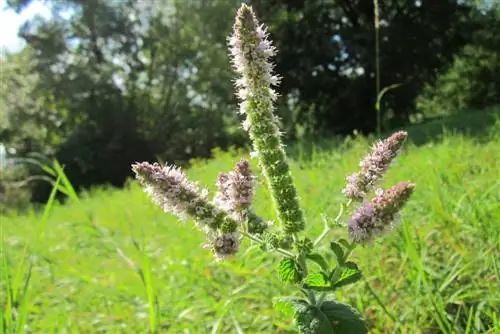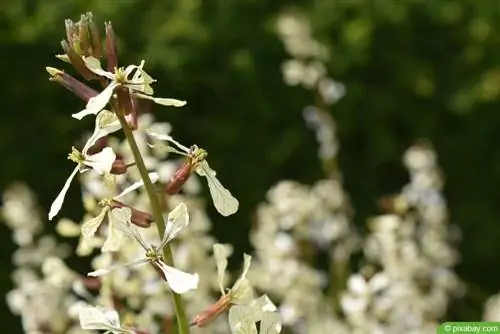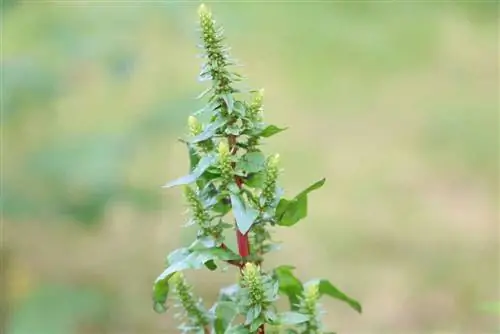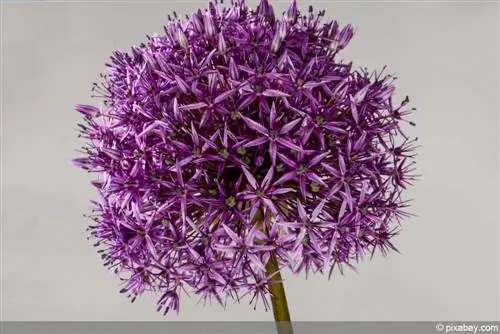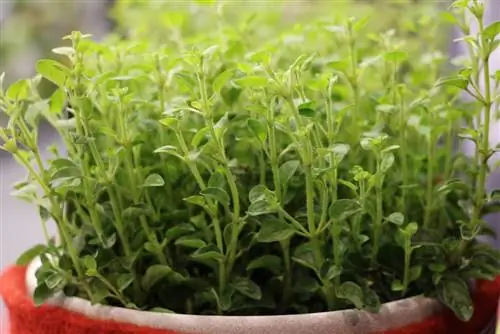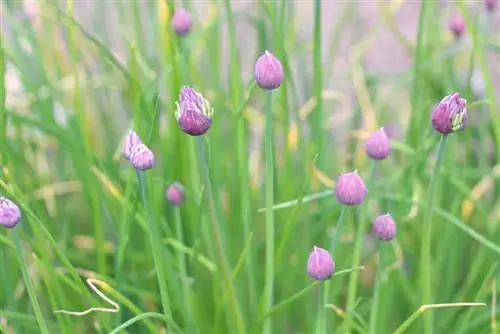- Author admin [email protected].
- Public 2023-12-17 03:39.
- Last modified 2025-01-24 12:45.
Many gardeners have a persistent rumor that the mint leaves can no longer be harvested once the herb plant begins to bloom. However, this belief is wrong because the flowering mint is definitely still edible. However, the leaves lose their delicate aroma during the flowering period as the plant invests all of its energy in the formation of the flowers. This is probably why there is a rumor going around that the flowering mint is no longer edible.
Flowering time
Depending on the variety, the flowering time falls in different months, but local peppermint blooms at the beginning of summer, while varieties from southern regions often only start flowering at the beginning of autumn. Just like any other plant, mint's primary goal with its flowers is to spread it as widely as possible. The flowers attract insects as pollinators so that they initiate fertilization. For this reason, at the beginning of the flowering period, the herb plant invests all its energy in the formation of the flowers, and shortly after successful fertilization in the growth of the fruits and seeds. There is not much power left for the leaves, whose spicy taste suffers.
- Normally the flowering period is from June to August
- Late flowering varieties bloom until autumn
- Forms spike-like panicles
- Small bell flowers follow
- Flower colors are pink, purple or white
- The leaves are most aromatic before flowering
Consumption
There is a persistent rumor in popular belief and among many hobby gardeners that the leaves of the mint can no longer be harvested when the herb plant is already in bloom. This rumor does not correspond to the facts, the mint does not become poisonous after flowering and is still suitable for consumption. However, the leaves are no longer as aromatic as they are right before flowering. As long as the mint is in full bloom in the garden or in the flower pot, the leaves should not be harvested. These are neither suitable for making tea nor for drying at this time.
- Leaves can also be cut off after the flowering period
- Leaves then taste less intense
- The flavor becomes a little bitter
- Flowers contain almost no aromatic substances
- It is better not to harvest leaves directly during the flowering period
Harvest
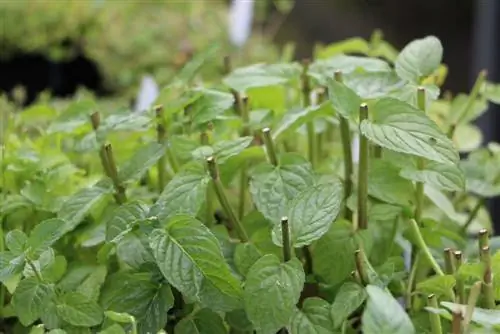
When the mint is about to bloom, a particularly large amount of essential oils are stored in the leaves. This time is the perfect time for harvest. If you are not entirely sure when your own mint will bloom, you should harvest it when the first buds form at the latest. When the herb plant has completely bloomed, the leaves can be used to make tea or as a spice for salads. If the mint is to be used fresh, then the leaves can be harvested at any time, there is no need to wait until shortly before flowering.
- Harvest shortly before flowering for drying and freezing
- Harvest is possible again after flowering
- Cut shoots about a hand's width above the ground
Tip:
If the summer was very sunny and warm, the mint will produce enough new essential oils until autumn and can be harvested again for drying. However, if the summer months were very rainy and cool, then drying the mint leaves is no longer worthwhile.
Drying
If the site conditions and care are right, then the mint can grow and thrive abundantly. The many excess leaves often cannot be eaten as quickly as they grow. However, these can be preserved by drying them. The dried herbal plant can be preserved for a long time and retains its aromatic note. This way you will have spicy mint leaves for preparing food and drinks all winter long. There are various methods to choose from for drying, which have their advantages and disadvantages.
- It is best to harvest the leaves in the late morning
- Cut stems low to the ground
- Do not wash harvested mint leaves as this will rinse out the essential oil
- The drying process is also extremely extended by washing
- Tie some stems into a bundle
- Hang upside down in a suitable place
- Airy attics and bright basement rooms are ideal as drying rooms
- Covered and wind-protected veranda is also possible
- Alternatively, drying in the oven or dehydrator is possible
- Normal drying takes about 2 weeks
- The oven or machine dries in just a few hours
Store
So that the leaves do not become damp again after drying, they must be stored away from moisture. Otherwise they can start to mold and then become inedible.
- Pour dried leaves promptly into a suitable container
- Glasses with screw caps are ideal
- Airtight plastic containers and vacuum bags are also suitable
Conclusion
Contrary to many traditions, mint does not become poisonous during the flowering period, but can still be consumed. However, the herbal plant loses its aromatic flavor during this phase and tastes significantly more bitter. Therefore, the stems should be harvested for drying before flowering so that there are still enough essential oils in the leaves. If you want to use the leaves fresh, you can harvest them at any time. However, the leaves taste very bland during the acute flowering period, so this should be waited. If warm weather with little rainfall sets in at the end of summer, then at the beginning of autumn the mint will produce more essential oils and will be ready for harvesting and drying again.

